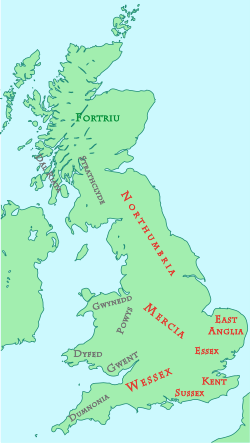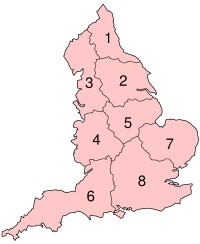Alternative
Cultural
Informal and overlapping regional designations are often used to describe areas of England. They include:
- Midlands, often considered interchangeable with Mercia
- Northern England
- Southern England
- The Hundred Parishes
- Home Counties
-
 Cinque Ports
Cinque Ports - West Country, often considered interchangeable with Wessex
- Cotswolds
- Weald
Heptarchy
Heptarchy, former kingdom names which did not become counties have continued to be recognised by organisations as regions:
 Wessex, generally interchangeable with the West Country (excluding Cornwall)
Wessex, generally interchangeable with the West Country (excluding Cornwall) East Anglia
East Anglia  Mercia, often considered interchangeable with the Midlands
Mercia, often considered interchangeable with the Midlands Northumbria, associated mainly with North East England (or the historic Counties of Northumberland and Durham), however, can also be considered interchangeable with Northern England
Northumbria, associated mainly with North East England (or the historic Counties of Northumberland and Durham), however, can also be considered interchangeable with Northern England
Counties
National parks
National parks include:
Britain in Bloom regions
Britain in Bloom divides England into 12 regions, bearing a mixture of government regions with some altered names. It also includes Cumbria, Thames-and-Chilterns (Berkshire, Buckinghamshire and Oxfordshire) and part of south east and south west as South-and-South-West.
National Trust
The National Trust has 10 regional offices in England. These are
- Devon and Cornwall – part of the official South West region
- East of England – as region
- East Midlands – as region
- North East England – North East England and Yorkshire and the Humber
- North West England – as region
- Thames and Solent – Berkshire, Buckinghamshire, London, Oxfordshire, Hampshire
- South East England – East Sussex, Kent, Surrey, West Sussex
- West Midlands – as region
- Wessex – South West England without Devon and Cornwall
Postcodes
Postcodes are used as alternatives to administrative units for statistics. Some areas and districts are close to geographic terminology where administrative borders differ, such as:
- The LA postcode area, covering Morecambe Bay
- PE, The Fens
- E, EC, N, NW, SE, SW, W and WC for Inner London




